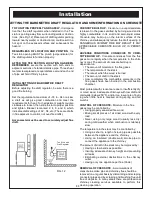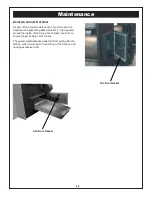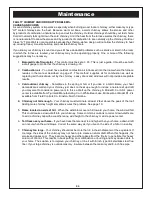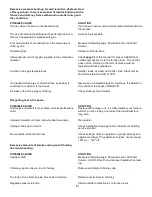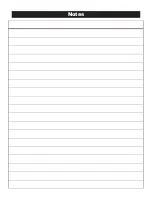
FAULTY CHIMNEY AND/OR DRAFT PROBLEMS -
CAUSES AND CURES
A sound chimney system is imperative, especially when burning wood. Indoor chimney, either masonry or type
“HT” metal chimneys are the best. Because warm air rises, a warm chimney allows the smoke and other
by-products of combustion a natural exit up and out the chimney. Outdoor chimneys should be your last choice.
Cold air naturally falls right down the cold chimney. Until the heat from the furnace warms the chimney, there
is no natural draft to allow the smoke and by-products of combustion to rise naturally up the chimney. Outdoor
Class “A” Triple Wall is not acceptable because their thermo-siphon design will not allow the chimney to heat
up, causing heavy creosote build-up and possible chimney fires.
If you know your chimney is sound and you still have downdraft problems such as smoke or smell in the room
in which the furnace is located, your chimney may not be operating properly. One or more of the following
suggestions may be necessary.
1.
Barometric draft regulator
- This control must be set at -.03. This is just a guide. It must be set with
a draft gauge to prove that the chimney is drawing .03.
2.
Combustion air
- You must have outdoor combustion air introduced into the room where the furnace
resides in the manner described on page 21. This method supplies air for combustion as well as
replacing air that is drawn out by the chimney. Leaky doors and windows will not provide acceptable
results.
3.
Cold outdoor chimney
- Sometimes in the spring or fall, or if you live in a mild climate, your heat
demands are small and your chimney just does not heat up enough to induce a natural exit up draft,
you may want to consider a power vent to force a draft up the chimney. A Model D-3 or AD-1 power
venter is available from Tjurnland Manufacturing Co. in White Bear Lake, Minnesota or Model D1-2 is
available from Field Controls Co., Kinston, North Carolina.
4. Chimney not tall enough
- Your chimney must terminate at least 2 feet above the peak of the roof.
Adding more chimney height sometimes cures the problem. See page 19.
5.
Home located on side of hill
- When the wind blows over a hill toward your home, the wind will fall.
This could cause a down-draft into your chimney. Some common solutions to correct down-drafts are
to add a chimney cap with a weather vane, add height to the chimney or add a power venter.
6.
Tall trees near your home
- If you have trees that are near to and higher than your home, a down-draft
can occur when the wind blows. Correct the same way as if you live on the side of a hill or in a valley.
7.
Chimney too large
- Your chimney should not be more than 8 inches in diameter or the equivalent. If
too large, the sides of the chimney may not heat up to create a natural draft. When this happens, the
smoke and gases cool . They become heavy and other gases from the fire try to penetrate this heavy
column of cool air. This results in back puffing, poor combustion or burning and may cause odors in
your home. The solution is to improve your chimney or line it with 8-inch type 304 stainless steel flue
liner. If your large chimney is outside masonry, insulate between the masonry and 8-inch flue pipe.
Maintenance
44
Summary of Contents for BIG BJ90
Page 11: ...3 1 2 4 5 6 7 8 9 Furnace Features SJ125...
Page 13: ...1 2 3 4 5 6 7 Furnace Features BJ90 13...
Page 46: ...SUPER JACK SJ125 Exploded Views Parts Lists 46...
Page 48: ...BIG JACK BJ90 Exploded Views Parts Lists 48...
Page 53: ...Notes...
Page 54: ...Notes Notes...
Page 55: ...Notes...




